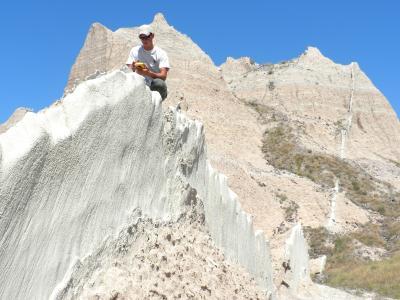Boulder, CO, USA - U.S. National Parks are not just beautiful vistas and great family vacation destinations; they are also key scientific field laboratories and rich repositories of the record of Earth's history. Some recent discoveries to emerge from scientists working in U.S. National Parks will be presented in two sessions, Geology in the National Parks: Research, Mapping, and Resource Management I and II, at the 125th Anniversary meeting of The Geological Society of America in Denver next week.
Some abstracts of interest include:
18-1: (8:15 AM) Findings by Robert B. Smith (University of Utah) and colleagues, that the Yellowstone crustal magma reservoir is three times larger than previously thought, and the biggest Yellowstone Plateau threat is from large M7+ earthquakes, not from giant volcanic eruptions: https://gsa.confex.com/gsa/2013AM/webprogram/Paper234134.html
18-3: (8:45 AM) A new National Park Service (NPS) inventory lists 128 parks with documented plant fossils, including petrified wood, leaves, flowers, seeds, cones, nuts, roots, pollen, and amber. These span the Precambrian to the Holocene, aiding our understanding of past climates and ecosystems that have existed across North America through time. Vincent Santucci (NPS) will describe the comprehensive inventory of paleobotanical resources: https://gsa.confex.com/gsa/2013AM/webprogram/Paper233514.html
18-4: (9:00 AM) After South Dakota's Fossil Cycad National Monument was created in 1922, scavengers stole all the fossils on the surface, and the park was decommissioned in 1957. Now researchers are trying to find the remaining buried fossils. John M. Ghist (NPS) will relate the interesting tale of this almost forgotten national monument: https://gsa.confex.com/gsa/2013AM/webprogram/Paper229546.html
18-7: (10:00 AM) "Street view" comes to Denali! Four vehicle-based cameras (facing to the front, rear, left, and right) will make an overlapping series of several hundred thousand high-resolution images capturing 360-degree views at bus window height along the 92.5-mile length of the park road. The aim is to establish a photographic baseline for monitoring future changes in the views of Alaska's Denali National Park and Preserve. In addition, Ronald D. Karpilo Jr. (Colorado State University) and Lacy N. Karpilo (University of Alaska-Anchorage) are using repeat photography of historic images (and showing the resulting photo pairs) to help document and interpret how park natural resources (such as glaciers, rivers, lakes, and vegetation) and cultural resources (such as roads, buildings, and mines) have changed during the past century: https://gsa.confex.com/gsa/2013AM/webprogram/Paper233873.html

This is GeoCorps participant Levi Moxness, National Park Service, Badlands National Park. Credit: GSA GeoCorpsTM America program.
(Photo Credit: : GSA GeoCorpsTM America program.)
78-3: (1:45 PM) Rising seas will alter the natural and cultural resources of 105 national parks in future years. At Cape Hatteras National Seashore and Everglades National Park, large areas will be submerged. Storm surges will make things worse. Maria A. Caffrey (University of Colorado-Boulder) outlines the work that is underway to respond to climate change in coastal national parks: Abstract: https://gsa.confex.com/gsa/2013AM/webprogram/Paper221754.html
WHAT: Sessions 18 and 78
Geology in the National Parks: Research, Mapping, and Resource Management I, https://gsa.confex.com/gsa/2013AM/webprogram/Session32622.html
Geology in the National Parks: Research, Mapping, and Resource Management II, https://gsa.confex.com/gsa/2013AM/webprogram/Session34404.html
WHEN: Sunday, 27 October 2013: 8:00 AM-12:00 PM and 1:00 PM-5:00 PM
WHERE: Colorado Convention Center Room 404
For more from the national parks, take a look at Monday's session "16 Years of GeoCorpsTM—Geoscience Projects Impacting America's Public Lands and Natural Resources I and II." At 1:15 PM Monday (abstract: https://gsa.confex.com/gsa/2013AM/webprogram/Paper226877.html), the National Park Service's Lisa Norby will give a retrospective on 16 successful years of the Geoscientist–in-the-Parks (GIP) program. In partnership with GSA's GeoCorpsTM America program, GIP places geoscientists in national parks where they have contributed nearly 450,000 hours of service to the American public on projects such as inventory and monitoring of Earth system resources, geoscience research, GIS projects, and education and outreach. This talk will showcase outstanding projects, accomplishments and benefits.
WHAT: Sessions 110 and 175
16 Years of GeoCorpsTM—Geoscience Projects Impacting America's Public Lands and Natural Resources I, https://gsa.confex.com/gsa/2013AM/webprogram/Session33312.html
16 Years of GeoCorpsTM—Geoscience Projects Impacting America's Public Lands and Natural Resources II, https://gsa.confex.com/gsa/2013AM/webprogram/Session34234.html
WHEN: Monday, 28 October 2013: 8:00 AM-12:00 PM and 1:00 PM-5:00 PM
WHERE: Colorado Convention Center Room 404
Source: Geological Society of America